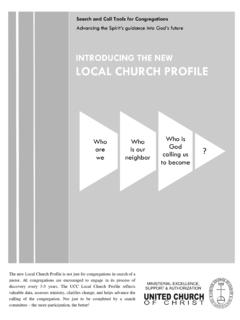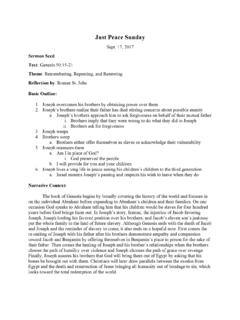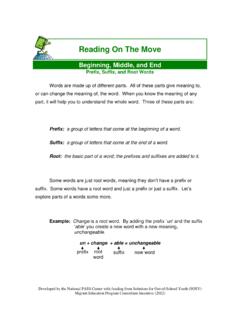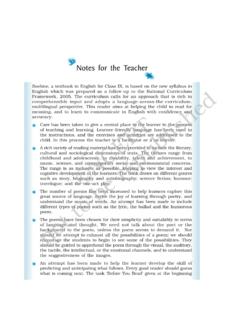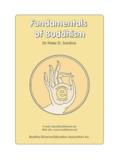Transcription of WHITE PRIVILEGE - uccfiles.com
1 WHITEPRIVILEGElet s talkA Resource for Transformational DialogueTraci Blackmon | John Dorhauer | Da Vita D. McCallister | John Paddock | Stephen G. Ray, OneThe Spiritual autobiography Told Through the Lens of Race Chapter 1: John Paddock Chapter 2: John DorhauerChapter 3: Da Vita D. McCallisterChapter 4: Traci BlackmonChapter 5: Stephen G. Ray, TwoWhiteness as the Norm: Five Loci of Insights on the Binary of Light/Dark and Black/ WHITE Chapter 1: Whiteness as the Norm: Reflections on How This is Evidenced and Experienced in AmericaChapter 2: Binary: Lightness and DarknessChapter 3: Iconography: The Investment of Whiteness in Narrating HistoryChapter 4: The WHITE JesusChapter 5: Lightness and Darkness as Experienced in the Genealogy and Liturgy of the Church Part ThreeThe Cash Value of Whiteness or Whiteness as a Tax-Exempt Status Chapter 1.
2 The Cash Value of Whiteness or Whiteness as a Tax-Exempt Status Stephen G. Ray, Jr. Chapter 2: How Education Advantages Whites John DorhauerChapter 3: How Housing Practices Advantage Whites John DorhauerChapter 4: How Income and Wealth Disparities Advantage Whites John PaddockChapter 5: How the Medical and Health Industries Advantages Whites Da Vita D. McCallisterPart FourOn Becoming an Ally Chapter 1: Da Vita D. McCallister Chapter 2: John PaddockChapter 3: Traci BlackmonChapter 4: John DorhauerChapter 5: Stephen G. Ray, of Useful Resources| 2| 5| 10| 15| 19| 25| 30| 37| 43| 51| 58| 64| 69| 74| 79| 84| 87| 91| 96| 98| 103| 1072 Greetings, gentle soul,I want to thank you for committing to an ongoing Sacred Conversation on Race, and for your willingness to enter into this particular aspect of the conversation that focuses attention on WHITE PRIVILEGE in its manifestations and impact.
3 We don t promise that this will be easy to discuss. It will challenge basic assumptions about race that help WHITE communities maintain a system of PRIVILEGE that, while prevalent, often goes unnoticed by even the best-intentioned of WHITE advocates for justice. Nonetheless, the work we do to deepen our awareness of how PRIVILEGE is made manifest, and the commensurate work of unmasking and dismantling that PRIVILEGE , is among the most important work we WHITE leaders can commit to. Be open to the challenges that will come. Promise to come to these conversations with open hearts and open minds.
4 Commit to new insights that will lead to new alignments. One of the pernicious and enduring characteristics of PRIVILEGE is that even whites who long ago became aware of the endemic racism in America, and who challenged themselves to grow beyond their racist pasts, are yet still recipients of privileges that give them enormous economic advantages. Even more insidious is that some of the most committed WHITE allies for racial equity remain largely unaware of the countless ways that PRIVILEGE manifests itself daily in their lives. This curriculum is a concerted effort to enable allies to see with new eyes how PRIVILEGE works.
5 It aims to illuminate how WHITE people in America, at every economic stratum and in a myriad of ways, receive privileged consideration simply because they are WHITE . It offers the promise and the possibility that those who commit to engaging in this dialogue can develop higher degrees of awareness of PRIVILEGE and its consequences. It is presented in the hope that such awareness, both in the individuals who participate in the curriculum and in the larger communities of which they are a part, will lead to more sophisticated and more impactful commitments to reducing the ongoing impact of WHITE PRIVILEGE as a means of distributing wealth and power.
6 It is important that some things be understood up front. First, this is but another step in an ongoing commitment to engage in Sacred Conversations on Race. It is not the end of any journey, and it is certainly far from the beginning. It is merely the next step. That is important to understand, because the focus of this work is somewhat narrow. If seen as an attempt to finish something completely, it will fail. Its narrow focus is on WHITE PRIVILEGE as seen through the lens of Black/ WHITE divisions in America. Other material is promised in time that will delve into how PRIVILEGE is filtered through the lenses of other disadvantaged communities: Indigenous American populations; Latino/a communities; Immigrant and refugee populations; the LGBTQ community; female and womanist perspectives; those differently made the choice to focus on one aspect of a conversation on PRIVILEGE that is crucial on our journey to racial equity knowing it could not complete introduction3the discussion.
7 It is our hope and our commitment that future material will enable us to continue this conversation further. Second, this material should not be used as a means for WHITE allies to address questions related to what whites can do to create racial equity. The work of unmasking and dismantling PRIVILEGE is important, and requires that whites everywhere learn to spot PRIVILEGE when and where it exists. But no one using this material should see it as a means of achieving racial equity. It is more appropriate to see this material as a means of reducing the impact of whiteness as a social construct, for it is the PRIVILEGE that emanates from the deployment of that construct that is the greatest impediment to racial equity America knows today.
8 WHITE participants should know up front that the hope here is not that we as whites be relied upon to resolve racial injustice and inequity, but that we commit to reducing the impact our WHITE PRIVILEGE has on creating that injustice and inequity. Third, the fundamental work to be done here is to focus on seeing. Jesus said Let those who have eyes to see, see. This is not as easy as it sounds the simple and hard truth is that most whites move through their days with a very deep denial, or at least a very shallow awareness, of how their PRIVILEGE works.
9 If you are a person of color in America, the seeing of PRIVILEGE is inescapable. If you are WHITE , you have most likely not been conditioned to even look for, much less see, where your PRIVILEGE functions. If there is one thing this curriculum seeks to challenge WHITE participants to commit to, it is seeing. Ask yourself every day this simple question: What do I see? Begin to filter all your experiences through the lens of race. For whites, that not only sounds challenging it sounds ridiculously unjust. After all, aren t we trying to reduce the impact of race?
10 Isn t our goal NOT to filter things through the lens of race? If you are a person of color, you know that there is not a day that goes by where you are afforded the luxury of NOT filtering your experience through the lens of race. WHITE people in America don t have to do that, and will find it difficult to begin thinking that way. It is the NOT seeing things through the lens of race that makes PRIVILEGE invisible to whites. Begin seeing. Be open to knowing what things happen or don t happen because you are WHITE . It will feel awkward, disruptive, and disorienting until it stops feeling that way.


